The United States of America exacts a tax from citizens everywhere in the world, it’s just not a visible one.
But given that Washington has no desire to defend democracy, should the rest of the world desire to defend the dollar?
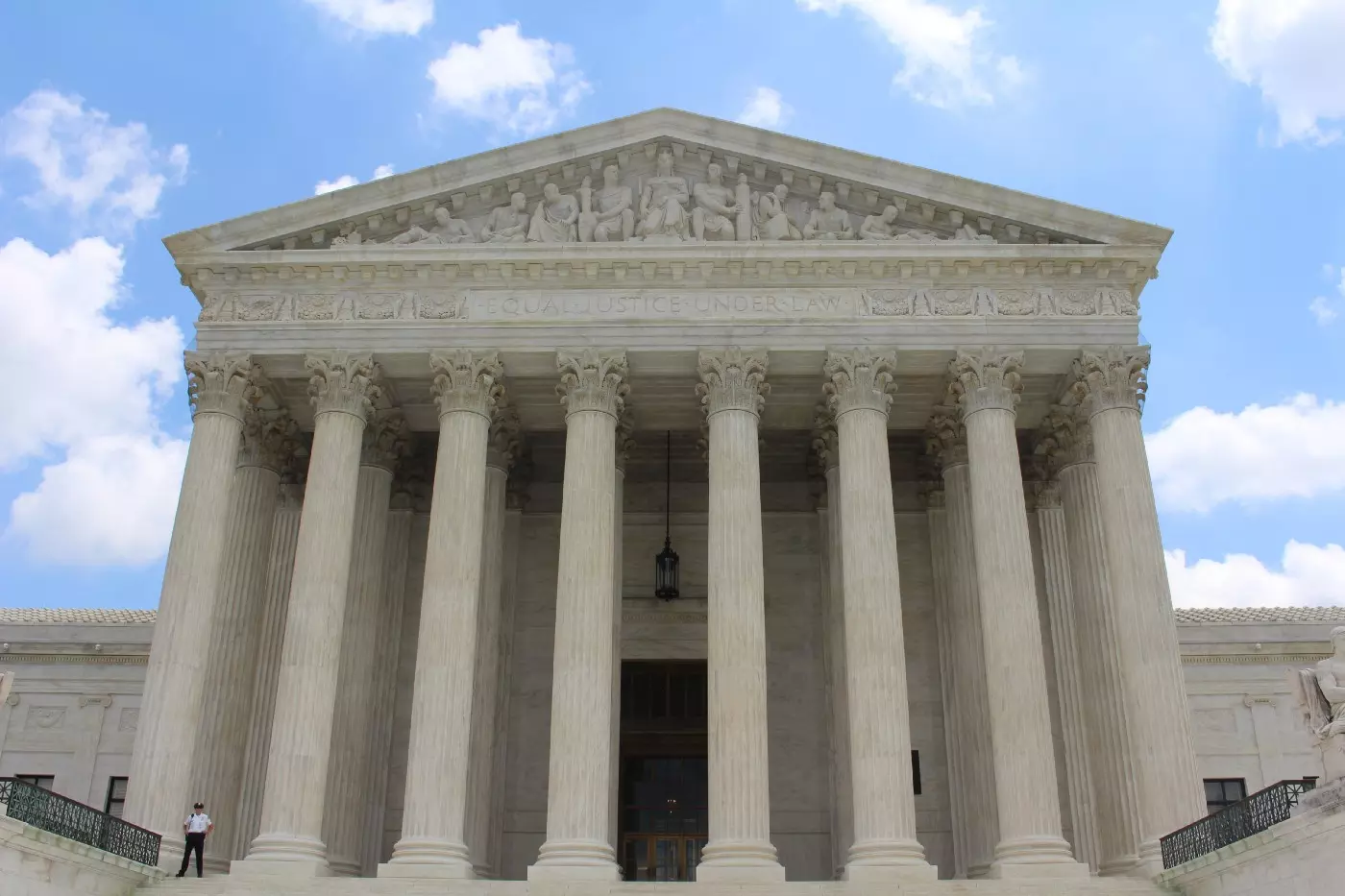
AsI sat at the kitchen table of my brother’s home in San Francisco while he was sorting out his 1040 (the U.S. Individual Income Tax Return form), he grumbled that while he felt it was his patriotic duty to pay these taxes, did they really need to make it so complicated?
“Well at least the Marines will come for you should things turn bad,” I quipped.
For millions of taxpaying Americans, doing their bit to foot the bill for Uncle Sam’s vast armada and armaments, is the price of entry into an exclusive club that comes with the implicit guarantee that wherever they may be on the planet, the Federal Government of these United States will send someone to rescue them should they ever need assistance.
From the Antarctic to the Andalusian Mountains, wherever there’s an American in need, there will be an American in deed.
Or will they?
You’re On Your Own
Because as artillery shells and rocket fire rained down on Ukraine’s cities last week, many Ukrainians would no doubt have been wondering where Uncle Sam was when they needed him the most.
As the world looked on in shock at the devastation wrought by invading Russian armies, what was perhaps even more disturbing was the shocking lack of intervention by the U.S. and United Kingdom, which had agreed to defend Ukraine’s territorial integrity in exchange for the country giving up its stockpile of nuclear weapons after the collapse of the Soviet Union.
What did the Ukrainians get for all of their U.S. tax dollars?
Not vey much at all.
But Ukrainians don’t pay any U.S. taxes after all, or do they?
Whether we like it or not, each and every one of us, no matter where we may be in the world, pays a U.S. tax, we just don’t notice it.
Every time you visit the gas station to pay for fuel, buy a loaf of bread or drink a glass of orange juice, you’re paying a tax to Uncle Sam.
And that’s because all of the commodities of the world that make life livable, are denominated in U.S. dollars.
Whether it’s copper or coffee, palladium or pork bellies, everything is based on the dollar and that’s because the world runs on dollars.
That a country that only makes up 25% of the global economy should have its currency command close to 90% of all foreign exchange transactions is no coincidence of history, it was paid for with American blood and treasure.
So How does Everyone in the World pay U.S. Taxes?
By denominating all of the world’s commodities in dollars, each and every time we use any of the commodities essential to life, we are paying for the United States of America to have the privilege to print more money.
And make no mistake about it, that privilege inures only to the United States of America, and to no other country.
Because commodities are priced in dollars, every other currency has to pass through the dollar-based global financial system to access those commodities.
And America is the only country in the world that has the ability to print as much money as it wants, without being at risk of devaluing its currency.
But with great power comes great responsibility.
As the global reserve currency, countries and individuals around the globe who hold dollars assume that Washington won’t print so many of the darned things that they become worthless — something that it has been on an almost relentless mission to do.
Since 2008, the U.S. has discovered that it can print as many dollars as it wants and the world will still buy them, so why stop?
The other reason the world still desires dollars is because as a global hegemon, there remained a belief that the United States of America would surely defend democracy wherever it may come under threat and was the only power in a position to do so.
In that sense, holding the dollar isn’t just a belief in America’s currency, it’s a vote in favor of democracy and a rules-based global world order backed by American money and might.
That belief would have been badly shaken the day the first Russian shell landed on Ukrainian soil against the backdrop of U.S. President Joe Biden declaring that no U.S. troops would be sent to defend Ukrainians against the onslaught.
Somewhere along the way, the United States of America forgot how it wrought its hard won privilege of the dollar as the world’s reserve currency — by sacrificing the blood and treasure of America in its defense.
By the end of the Second World War, over 400,000 American sons and daughters, fathers and mothers, husbands and wives, would give up their lives in the defense against tyranny and usher in the era of the dollar.
On July 1, 1944, just under a month after the first D-Day landings took place, delegates from the allied nations met at the secluded Mount Washington Hotel in Bretton Woods, New Hampshire to establish a new international monetary system.
Up until the First World War in 1914, most countries followed the gold standard, meaning that each country could guarantee it would redeem its currency for its value in gold.
However, when hostilities broke out across Europe, countries needed to cut the tie to gold so they could print the currency needed to pay for their war costs.
This increase of currency, more money chasing the same amount of goods and services, caused hyperinflation and the supply of money overwhelmed demand.
After the ruinous First World War, many countries recognized the folly of an “unbacked” currency and returned to the relative safety of the gold standard.
All went well until the Great Depression.
Following the 1929 stock market crash, investors dumped equities and switched to commodities trading, driving up the price of gold and resulting in people redeeming their currencies for gold.
Meanwhile, countries started engaging in trade wars, lowering the value of their currencies to increase trade and raising tariffs against each other, which laid the economic foundation for the Second World War.
Recognizing the economic factors that precipitated the Second World War, the Bretton Woods agreement, involving the ultimately victorious allies, was intended to usher in a new global monetary world order centered on the dollar, and to avoid a free-floating fiat currency system open to abuse.
The Bretton Woods agreement compelled its signatories to avoid trade wars through currency manipulation, and countries would maintain fixed exchange rates between their currencies and the dollar.
If a country’s currency became too weak relative to the dollar, the central bank of that country would buy up its currency in foreign exchange markets.
If however a currency’s price (relative to the dollar) became too high, that country’s central bank would print more money, increasing the supply and lower the purchasing power to keep the fixed peg with the dollar.
But Why Dollars?
Because the United States held 75% of the world’s supply of gold at the time, no other central bank had enough gold to back their currency as a replacement.
The dollar’s value was pegged to 1/35 of an ounce of gold and exchangeable for it.
This is how Bretton Woods allowed the world to gradually transition from the gold standard, to the dollar standard and over time, the dollar became a substitute for gold.
But that transition created more demand for dollars, even though its worth in gold remained the same.
Sensing the demand, successive governments of the United States of America after Bretton Woods took a leaf out of the Roman Empire’s playbook — by debasing the dollar.
After all, since there was so much demand for the greenback, why not just print more?
For those who were buying up the dollar to hold as foreign reserves, what was the risk? After all, they could always swap those dollars in for their equivalent value in gold.
And as the dollar’s popularity grew globally, it came to pervade every corner of the global financial system concentrating tremendous power between the cities of Washington D.C. and New York.
But while post-war U.S. administrations were more than happy to print as many dollars as they deemed fit, as the economies of Europe and Japan recovered from the economic disaster wrought by the conflict, they started to produce more of the goods that the rest of the world wanted, including America.
Suddenly Japanese and German cars were no longer seen as carriages of fascist ideologies, but economical, reliable and high performing vehicles.
As Germany and Japan made leaps and bounds manufacturing everything from machine tools to electronics, America’s industrial stock also started to decline, which meant that the U.S. had to print more of those dollars for those Datsuns and Daimlers that Americans wanted.
By 1971, all that dollar printing finally caught up with the United States, and the country fell victim to massive stagflation — a combination of high inflation and negative economic growth, otherwise known as a recession, causing unemployment to soar.
In response to the dangerous dip in value caused by far too many dollars in circulation, then-U.S. President Richard Nixon started to deflate the dollar’s value in gold (in reality this had already been happening for years, but Nixon was the first to officially acknowledge it) repegging the dollar initially to 1/38 of an ounce of gold (from 1/35 at Bretton Woods) and then to 1/42.
Instead of helping, Nixon’s devaluation “declaration” backfired — when other countries got wind of the fact that those fistful of dollars they held weren’t necessarily as good as gold, there was an almost instantaneous run on U.S. gold reserves at Fort Knox as people rushed to redeem their quickly devaluing dollars for gold.
By mid-August of 1971, Nixon had no choice but to completely unhinge the value of the dollar from gold altogether and without price controls, gold almost immediately shot up to US$120 per ounce in the free market, thus ending the Bretton Woods system.
But while the world may have abandoned Bretton Woods, despite expectations that the dollar would decline, it actually became even more dominant.
Dollar Domination
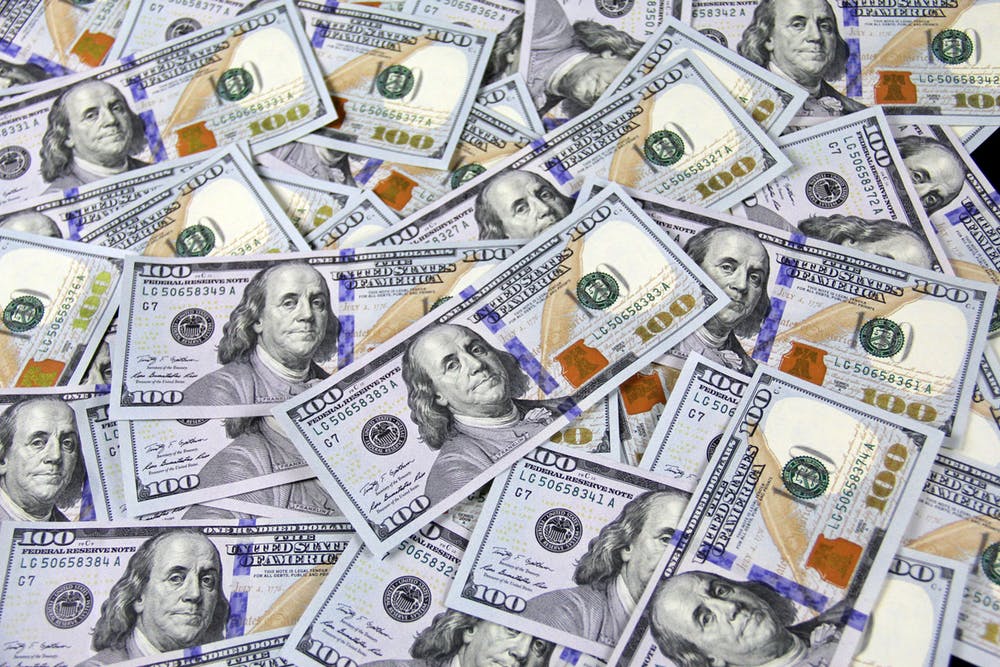
Given that there were no real alternatives to the dollar as a reserve currency and its already entrenched status in the global financial system, a combination of inertia and resignation, meant that the dollar’s dominance continued to grow, encouraging American profligacy, on the assumption of American exceptionalism.
And while that exceptionalism has been questioned on many occasions since the end of Bretton Woods, not since the shameful withdrawal from Afghanistan and the cynical treatment of Ukrainians as they continue to suffer at the hands of Russian invaders, has it been seriously doubted.
The world will not soon forget images of desperate Afghans clinging to the exterior of a U.S. Airforce C-17 as it lifted off from Kabul International Airport, eventually falling to their deaths on the vain hope that they could have clung their way to freedom and a better life.
Nor will the world soon forget how in early February, before the first Russian soldier set foot in Ukraine, U.S. President Joe Biden declared that he would not send troops to Ukraine, not even to rescue Americans.
In an interview with NBC News anchor Lester Holt, Biden in as plain English as possible told Americans still stuck in Ukraine that they were pretty much on their own and would need to rely on the sensibilities of Russian President Vladimir Putin,
“(If Putin) is foolish enough to go in, he’s smart enough not to, in fact, do anything that would negatively impact on American citizens.”
When pressed further by Holt,
“Have you ever told him (Putin) that?”
“Yes.”
“You’ve told him that, that Americans will be a line that they (the Russians) can’t cross?” Holt asked.
“I didn’t have to tell him that. I’ve spoken about that. He knows that.”
Sorry brother, I guess the Marines aren’t coming for you if things go wrong, Biden wants to keep them at Fort Bragg.
You may just want to re-look your 1040 and maybe pen in a few extra deductibles.
How fast America’s politicians forget how the dollar got to be dominant in the first place.
Wars tend to be major junctures for global currencies and with Russia losing access to its foreign currency reserves as Western sanctions threw its banks off the SWIFT system, several messages are being communicated to all countries, all of which do not bode well for the dollar:
In which case, it may make less and less sense for global reserve managers to hold dollars for safety, given that there is just the outside chance they could be taken away right when they’re most needed.
The dollar isn’t “censor proof.”
If Washington decides that your dollars no longer belong to you, it can and Russia is hardly the first country to be schooled in Dollar Dynamics 101 in recent months.
Uncle Sam Doesn’t Have Your Back, But He Does Have Your Dollars
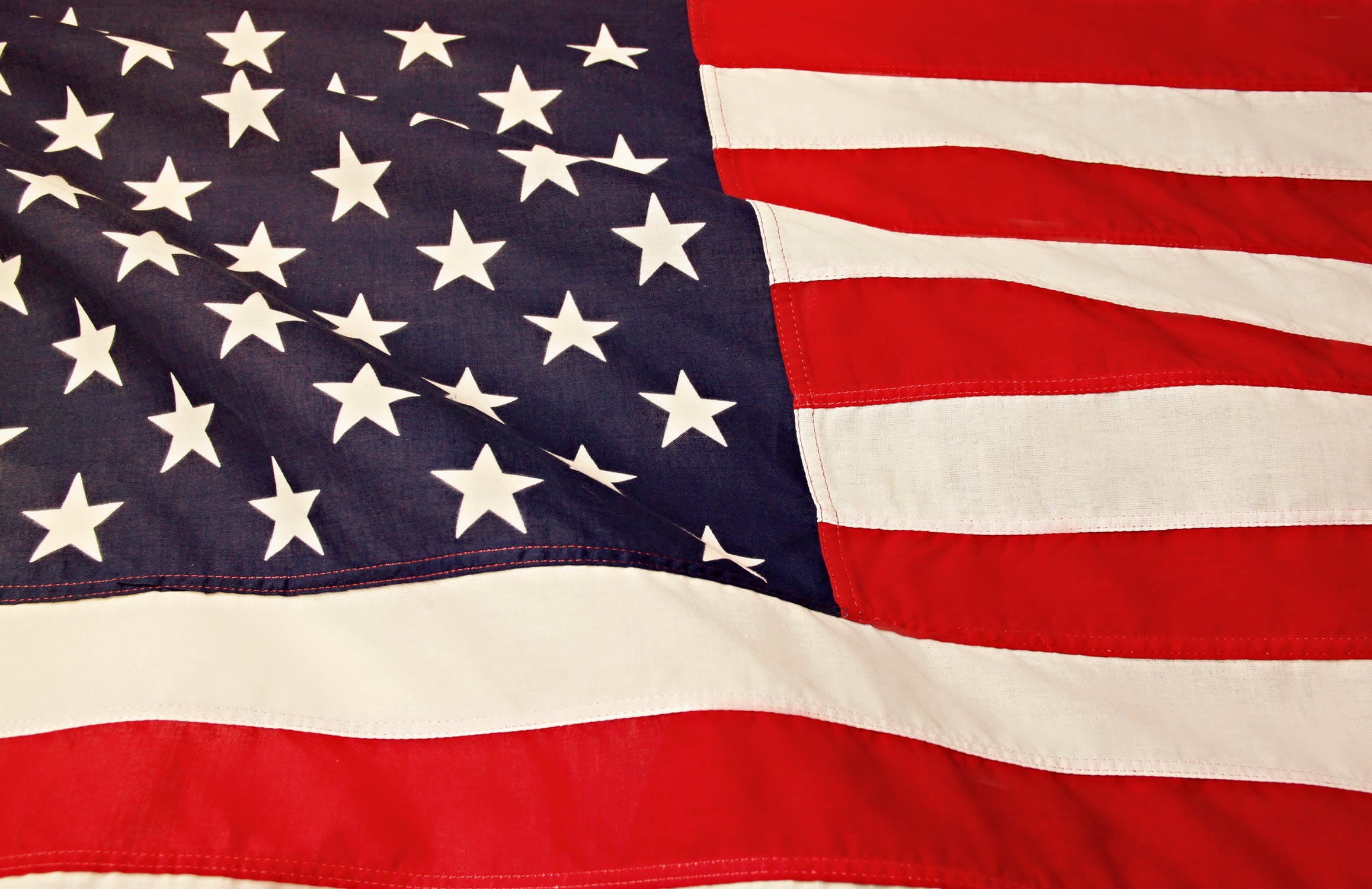
Soon after the U.S. exit from Afghanistan, the Biden administration moved to seize the country’s cash assets and prevent the Taliban from accessing it, making it impossible for the Taliban to meet even the most basic public service needs and putting an already impoverished country on the brink of famine.
While the U.S. may not have wanted the Taliban to come to power or fund its operations, the people who genuinely suffered were ordinary Afghans whom the U.S. had abandoned.
While similar scenes aren’t yet being played out on the streets of Moscow or St. Petersburg, depositors lining up outside Russian banks to get whatever currency they can out of the financial system are a throwback to the Soviet era and not in a good way.
Regardless of one’s views of another country’s governing system, central banks watching the events of the past year will be derelict in their duty if they weren’t at the very minimum entertaining the thought of diversifying away from the dollar, not least of which would be the People’s Bank of China.
With an estimated US$1.1 trillion of U.S. Treasuries, China is one of the world’s two largest holders of U.S. debt, second only to Japan with US$1.3 trillion.
And while one could argue that the U.S. never really saw Ukraine as a key ally, Washington’s guarantee in 1994 to defend Ukraine’s territorial integrity in exchange for the surrender of its nuclear stockpile and recent failure to do so, will no doubt weigh heavily on even the most pro-American Japanese central banker should hostilities ever break out between Tokyo and Beijing.
As such, it would be completely understandable if central banks tried to re-anchor their currencies to assets that were less susceptible to influence from either the U.S. or European governments, just in case.
But What Asset?
To understand what that asset could be, it’s important to first understand the different types of money held by governments.
Using a classification posited by the global head of short-term interest rate strategy at Credit Suisse, Zoltan Pozsar, there at two types of money held by governments — inside money and outside money.
Most of the world’s money is inside money, meaning that it’s money you’re owed.
The number you see on your bank account doesn’t represent some kind of cash deposit in a vault somewhere, it’s simply a promise by the bank to you that it will pay you that amount should you need it — an IOU.
That same concept applies on a sovereign scale — foreign reserves, for the most part dollars, are promises that the U.S. government will hand over the money to you when you need it.
But as Russia and Afghanistan have discovered in recent times, that promise is far from absolute.
Outside money on the other hand, according to Pozsar, is money that isn’t some else’s liability, a country or an individual custodies that money themselves and could be anything from physical cash to Bitcoin and for a country, that could be gold.
Take Russia for instance, which as recently as January, held over US$120 billion worth of gold, more than its actual dollar-denominated holdings.
But Russia is hardly the only country stockpiling gold, with central banks around the world increasing the gold they held in reserve to a 31-year high in 2021.
According to the World Gold Council, the international research organization of the gold industry, central banks have built up their gold reserves by more than 4,500 tons over the past decade, the highest pace ever.
Coincidence?
Now that Russia has lost access to its dollars and euros, gold is effectively its primary holding, with Pozsar seeing the potential for the ruble to become de facto, or literally, backed by gold.
Speaking on Bloomberg’s Odd Lots, Pozsar noted,
“Most FX reserves that exist in the world today are all forms of inside money, i.e. they are the liabilities of someone.”
“Whether you hold the sovereign debt of a country, or you keep a deposit at a central bank of a foreign country, or if you keep deposits at Western financial institutions, these are all forms of inside money that you don’t control. Someone owes it to you. And these things can be sanctioned.”
Pozsar isn’t alone in his view.
Dylan Grice, a former Societe Generale strategist and founder of Calderwood Capital described in a tweet Washington’s “weaponization” of money as a card you could only play once.
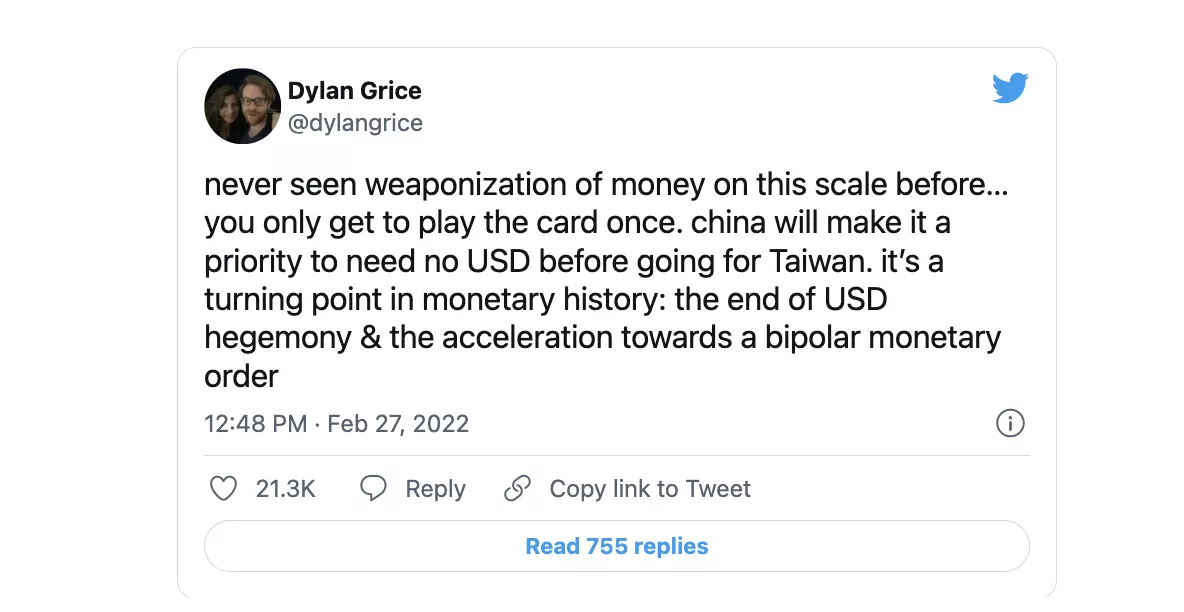
Speaking to Bloomberg, Managing Director at Standard Charted Bank Steven Englander echoed that idea, noting,
“It’s a very long-term thing, so nothing immediate or even say on a two- to three-year basis, but if what we are seeing is a demonstration of the power of economic and financial force, the logical response if there is a risk that you will be on the receiving end is to see what you can do to immunize yourself.”
Predicting the dollar’s demise however is hardly new.
For years, soothsayers have repeatedly foretold of the dollar’s imminent demise, only to have it grow from strength to strength even as the U.S. accounted for a smaller and smaller share of the global economy.
One of the biggest reasons of course that the dollar hasn’t descended into obscurity is the lack of alternatives and the infrastructure that supports it.
Countries with large amounts of dollar-denominated reserves will need to find a place to get rid of them? The world can’t all suddenly sell their dollar reserves, there just wouldn’t be a big enough buyer outside of the U.S. itself.
And more importantly, central banks can’t just sell their dollar assets, they also need to find something else to buy.
While gold is an obvious candidate, there’s only so much of it available and one reason why the rise of the collective dollar holdings of central banks has easily surpassed that of gold in recent years.
Some have suggested Asian currencies or bonds, but these markets are far less liquid than U.S. ones, making it difficult for countries like Russia or China to stash their cash in these assets.
Could Bitcoin be the Alternative?
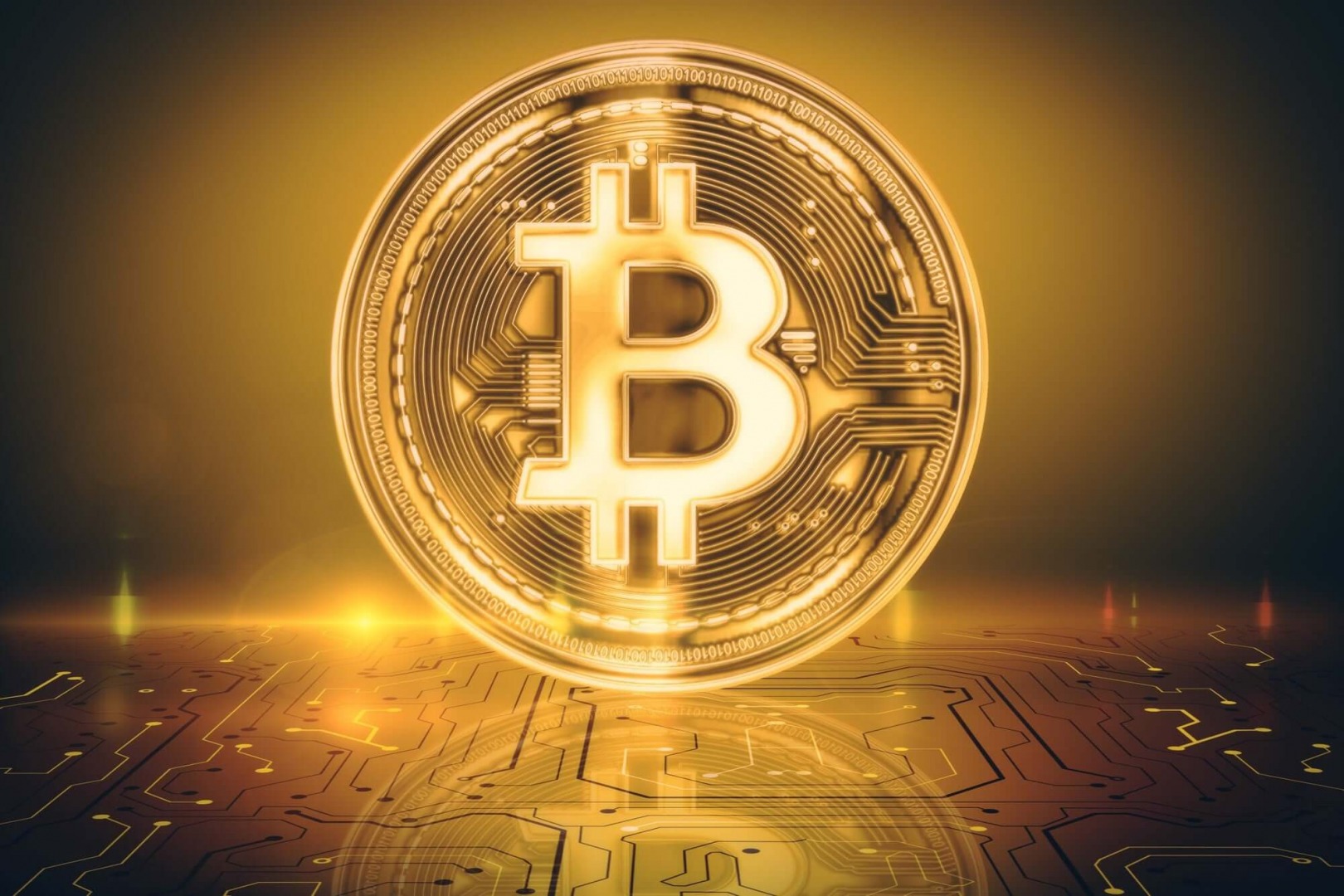
It may already.
Bitcoin is algorithmically-limited to 21 million and without a central bank or single administrator, can be sent directly from peer-to-peer without the need for intermediaries.
Because Bitcoin does not have a central authority that controls it, it arguably comes as close as possible to a democratic currency — anybody can access it, anyone can mine it, and its issuance is decentralized.
Anyone can send a Bitcoin transaction to the network without needing any approval and the network merely confirms that the transaction is legitimate.
That Bitcoin works exactly as how it was intended was on full display in the immediate aftermath of Western sanctions disconnecting Russian banks from the SWIFT interbank messaging system that facilitates international transfers.
As the Russian ruble went into freefall on the Monday after Russian banks were excluded from SWIFT, ordinary Russians raced to ATMs and banks to empty out whatever cash they could find, buying up electronics and appliances and swapping the ruble for whatever hard currency they could access as the value of their money rapidly started to evaporate.
Russians and Ukrainians also raced to buy cryptocurrencies, sending Bitcoin and others like Ether surging overnight.
The belief that Bitcoin and other cryptocurrencies could serve as a possible hedge in the event of geopolitical turmoil was seen as largely academic, but now, the nascent asset class was proving itself in real time.
On that Monday, trading between the Russian ruble and Bitcoin, which is pegged to the U.S. dollar doubled to around US$60 million a day, according to data from Chainalysis.
Speaking to Bloomberg, Mike Novogratz, CEO and founder of cryptocurrency platform Galaxy Digital noted,
“We’ve never had a group of nations in essence confiscate real estate from Russian tycoons, taking a country’s money. That’s why Bitcoin was created, because people don’t trust governments. This is a big deal — in a lot of ways, this is starting the acceleration of de-dollarization of the world.”
On the streets of Moscow, Illarion, a 37-year-old Russian programmer speaking to the Financial Times embodied the sense of realization and growing distrust over government-issued currency,
“We are now wondering whether the state is going to forcefully convert dollar savings into rubles to take the citizens’ dollars because they are being cut off from the outside. That is a reality we see on the horizon.”
“I don’t think it is a joke any more that we may have bombs flying at us and we’ll need to flee the country, which requires having dollars in cash or cryptocurrency.”
Bitcoin today is a far larger asset than in the 2010s, with its market cap flirting with the US$1 trillion level on a regular basis.
Despite its volatility, the process of Bitcoin adoption by individuals and institutions continues apace, starting with hedge funds, then banks.
Now pension funds, endowments and sovereign wealth funds are sniffing around.
It’s more a matter of “when” rather than “if” a respectable central bank outside of El Salvador declares that it has some Bitcoin in its reserves, perhaps one day to back its own currency as well.
In many ways, the prospect of central banks anchoring their currencies to Bitcoin may make far more sense than our current dollar-based system.
The world’s acceptance of the post-war dollar-based system was borne out of a belief in American exceptionalism, and the guarantees provided by Pax Americana.
What the world needs to ask itself now is why it’s continuing to pay its share of Tax Americana, without receiving its share of Pax Americana?
Why should the world continue to fund American profligacy, to allow the U.S. Federal Reserve to “reserve” the right to print as many dollars as it wants, without having to back those dollars with blood and treasure?

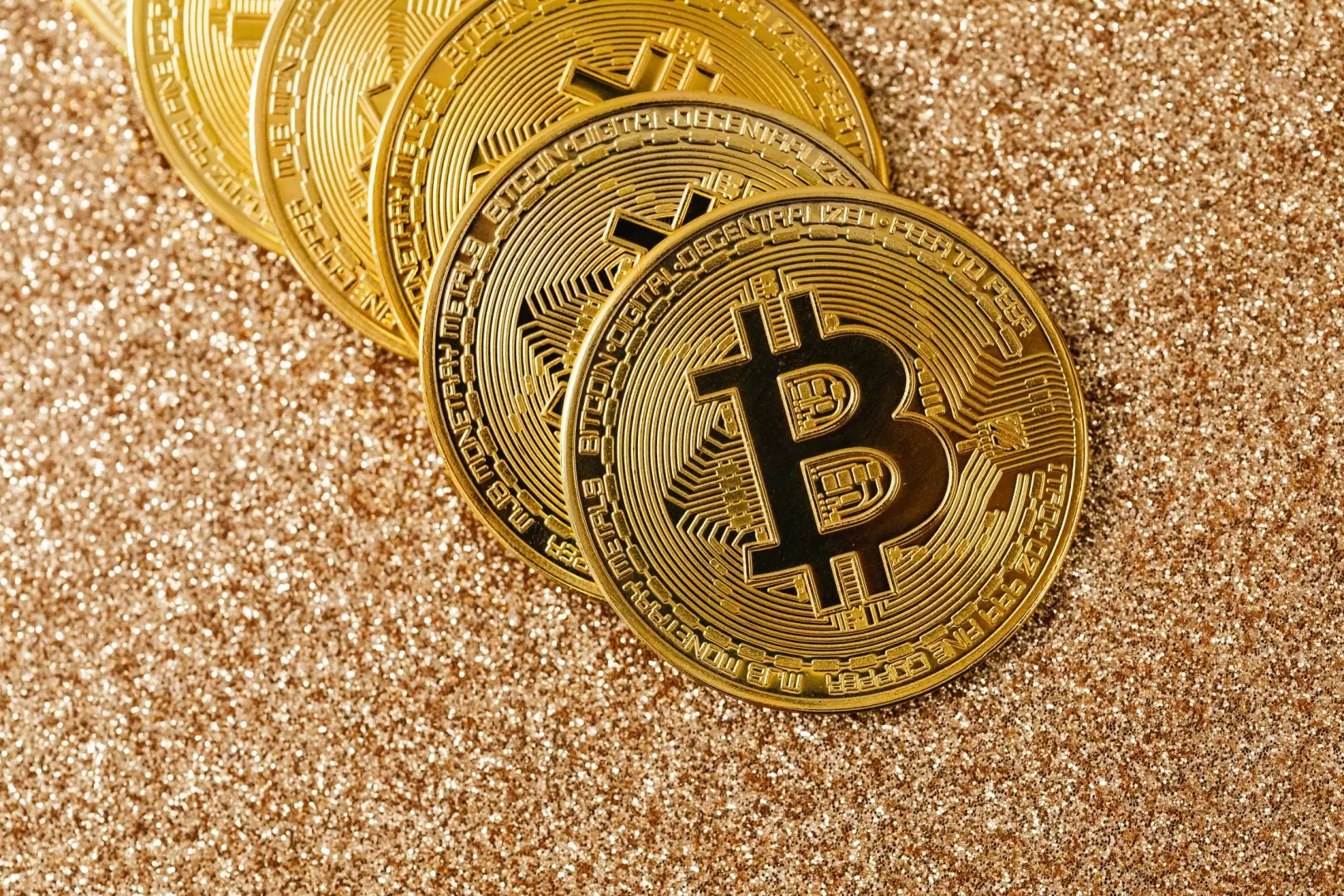






Leave your comments
Post comment as a guest